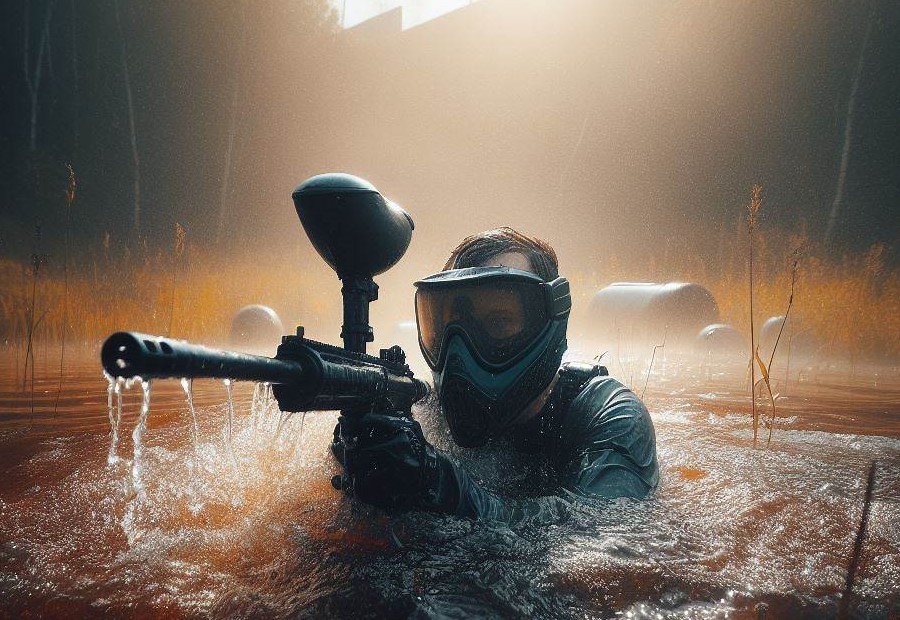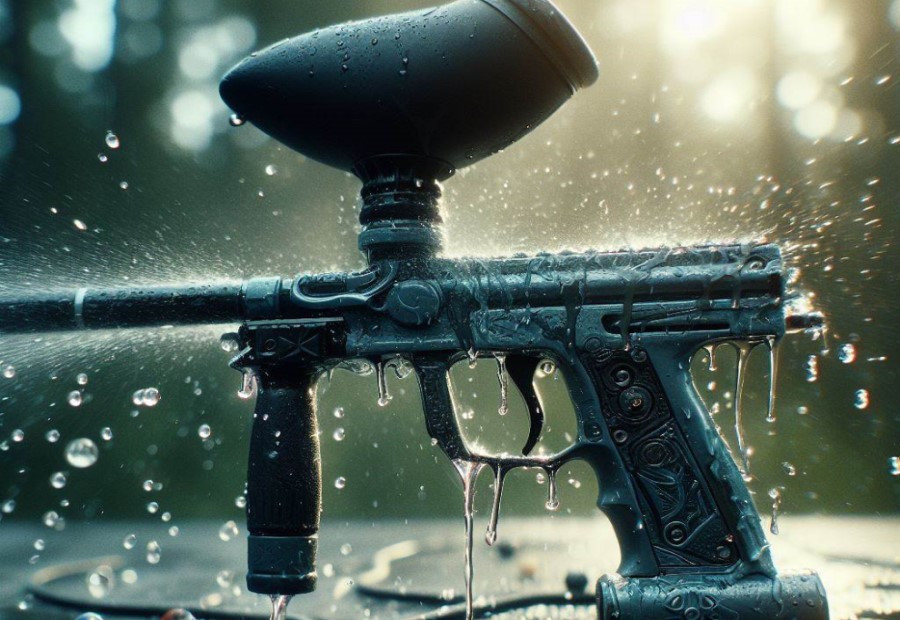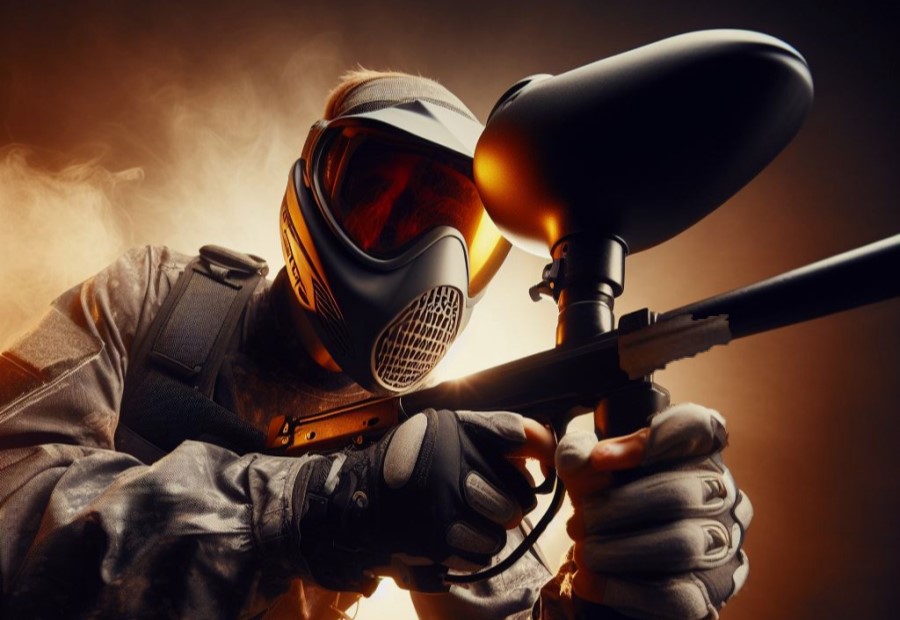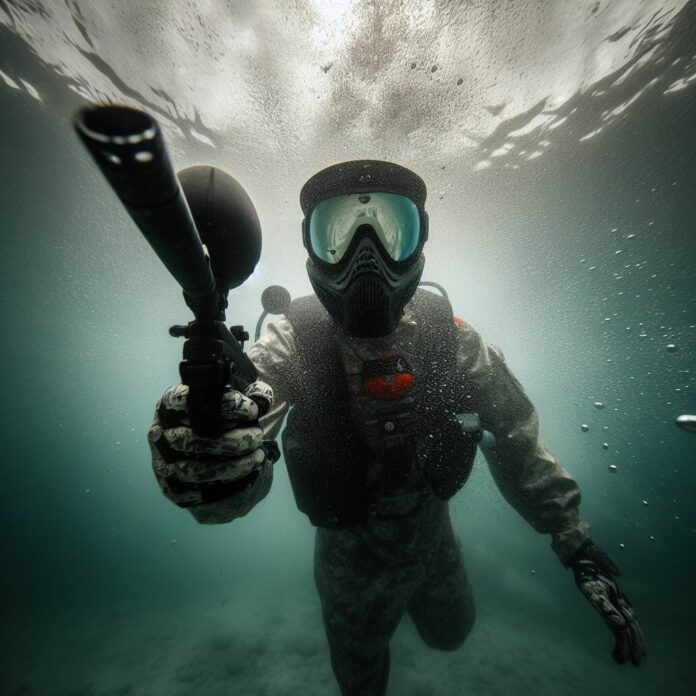Using a paintball gun underwater may seem like an intriguing idea for some adventurous individuals. However, it raises questions about the feasibility and effectiveness of such a concept.
To determine whether a paintball gun can be used underwater, several factors need to be considered. This article explores the possibilities and limitations of using a paintball gun underwater, delving into the physics and challenges involved.
It examines the potential consequences of using a paintball gun underwater, including decreased accuracy and range, increased water resistance, and potential damage to the gun.
Furthermore, the article investigates whether there are specialized paintball guns designed specifically for underwater use. By understanding the complexities and limitations, enthusiasts can make informed decisions about using paintball guns in aquatic environments.
Can You Use a Paintball Gun Underwater?

The answer is no, you cannot use a paintball gun underwater. Paintball guns are specifically designed to function in air, not underwater. The water pressure when submerged can actually cause damage to the gun and prevent it from properly expelling the paintballs.
It’s a matter of physics – the paintballs would not travel effectively through the water as they rely on air pressure to propel them at a high velocity.
Understanding Paintball Guns

Paintball guns are air-powered devices used in recreational and competitive games. They propel small paint-filled capsules at high velocities. The guns operate by using compressed air or carbon dioxide to create pressure that propels the paintballs.
Understanding paintball guns involves knowing key components such as the marker, hopper, and air system. The marker is the main part of the gun that houses the firing mechanism.
The hopper holds the paintballs and feeds them into the marker. The air system provides the force needed to shoot the paintballs.
To effectively use a paintball gun, it is important to have a deep understanding of paintball guns. This includes knowing how to properly aim, fire, and maintain the equipment. It is also crucial to follow safety guidelines to prevent accidents or injuries.
Understanding how to adjust velocity, clean the gun, and troubleshoot common issues are essential skills for any paintball player. Having a thorough understanding of paintball guns allows players to maximize their performance and enjoyment during games.
By having a comprehensive understanding of the different components and functions of the gun, players can make informed decisions when purchasing and customizing their equipment.
Mastering the techniques of shooting and maintaining the gun also contributes to a better overall paintball experience. So, never underestimate the importance of understanding paintball guns.
How Do Paintball Guns Work?
Paintball guns operate by utilizing either compressed air or CO2 to propel small paint-filled capsules called paintballs. When the trigger is pulled, the gun’s internal tank releases the air or CO2, forcefully expelling the paintball from the barrel.
To supply the paintballs, the gun is equipped with a hopper or magazine that feeds them into the chamber, ready to be fired. Several components of the paintball gun work together to enable its proper functioning.
These include the barrel, which acts as a guide for the paintball’s trajectory, the firing mechanism responsible for releasing the air or CO2, and the regulator that controls the gas pressure.
Additionally, a safety mechanism is incorporated into paintball guns to prevent accidental firing. The physics behind a paintball gun’s operation are relatively straightforward.
By releasing the gas, a propulsive force is generated, driving the paintball forward. The paintball’s accuracy and range are influenced by factors such as its shape, weight, and launch velocity.
Using a paintball gun underwater presents a variety of challenges. Water resistance diminishes the speed, range, and accuracy of the paintball. Moreover, if water infiltrates the gun’s internal components or barrel, it can cause damage.
While specialized paintball guns intended for underwater use do not exist, there are alternative water-based games that simulate the experience. These games commonly involve unique equipment and rules implemented to ensure both safety and enjoyment.
What Are the Components of a Paintball Gun?
The components of a paintball gun, also known as markers, include the barrel, marker body, hopper or loader, air tank, trigger, and bolt assembly.
These components work together to ensure the proper functioning of a paintball gun, determining its accuracy, power, and overall performance.
- Barrel: A long tube serves as the pathway for the paintball to travel. It has a smooth bore to minimize friction and ensure accurate shots.
- Marker body: Houses all the internal components of the paintball gun. It provides structure, stability, and protection for these components.
- Hopper or Loader: Is responsible for storing the paintballs. It feeds the paintballs into the marker’s chamber, allowing them to be fired.
- Air Tank: Holds the compressed air or CO2 that powers the paintball gun. It provides the necessary force to propel the paintballs out of the barrel.
- Trigger: Serves as the mechanism for firing the paintball. When pulled, it releases the compressed air or CO2, resulting in the paintball being shot.
- Bolt Assembly: A crucial component responsible for various tasks. It chambers the paintball, seals the breach, and controls the flow of air or CO2 to ensure proper firing.
These components work in harmony to create a functional and efficient paintball gun. Each component has a specific role in the firing mechanism, contributing to the overall performance and effectiveness of the gun.
Physics and Ballistic Trajectory
Paintball guns extensively rely on the principles of physics and ballistic trajectory to launch paintballs accurately and swiftly. When a paintball gun is discharged, a burst of compressed gas, typically CO2 or compressed air, propels the paintball out of the barrel.
The force exerted by the gas generates a forward motion, while the paintball’s shape and weight determine its trajectory.
The physics governing the ballistic trajectory of a paintball encompass crucial factors such as gravity, air resistance, and velocity. As the paintball traverses through the air, gravity pulls it downward, resulting in a curved path.
Additionally, air resistance influences the trajectory of the paintball by decelerating it and altering its flight path.
The velocity at which the paintball departs from the barrel plays a pivotal role in determining its range and accuracy. Higher velocities yield extended range, but they can also compromise accuracy due to the effects of drag and air resistance.
Striking the right balance in terms of velocity is paramount to achieve the optimal trajectory for precise shots.
Comprehending the intricacies of physics and ballistic trajectory in the context of paintball guns is imperative for players seeking to enhance their aiming skills and accuracy.
By mastering these concepts, players can effectively anticipate the behavior of paintballs and accordingly adapt their shots, ultimately resulting in a more enjoyable and competitive paintball experience.
Ammunition Performance
The ammunition performance of a paintball gun is significantly affected when used underwater. Here is a table illustrating the key aspects of ammunition performance in this context:
| Aspect | Performance |
|---|---|
| Accuracy | Decreased due to the resistance and drag of water on the paintball. |
| Range | Reduced as water acts as a barrier, slowing down the paintball more quickly compared to its performance in air. |
| Velocity | Lowers due to the increased water resistance, resulting in a slower speed of the paintball. |
| Trajectory | Altered due to the water’s impact on the flight path, causing deviations and unpredictability in the paintball’s path. |
| Breakability | The paintball may break prematurely, leading to a loss of its intended impact and mark on the target. |
| Ammunition Efficiency | Reduced as water can affect the integrity of the paintball, potentially leading to wastage or malfunction. |
Considering these factors, it is evident that the ammunition performance of a paintball gun is compromised underwater. The paintballs experience decreased accuracy, range, velocity, and efficiency when compared to their performance in air.
Additionally, the trajectory may become unpredictable, and the breakability of the paintballs might be compromised.
In view of these challenges, it is not recommended to use paintball guns underwater. Instead, individuals interested in water-based activities could explore alternatives such as underwater paintball-like games or other recreational water sports.
These alternatives offer a safer and more enjoyable experience while maintaining the excitement of water-based activities. Remember to always prioritize safety and adhere to any rules or regulations when participating in water sports or games.
What Happens When You Use a Paintball Gun Underwater?

Ever wondered what would happen if you decided to use a paintball gun underwater? From decreased accuracy and range to increased water resistance, we’ll uncover the unexpected effects that occur when paintball guns meet water.
Hold on tight as we dive into the potential damage that can be inflicted on the gun itself.
Decreased Accuracy and Range
Using a paintball gun underwater leads to a decrease in both accuracy and range. The physics of water have a significant impact on the performance of paintball ammunition.
The resistance from the water creates drag, which slows down the paintball, reducing its velocity and altering its trajectory. Consequently, the accuracy of paintballs is compromised, and their range is shortened in comparison to their performance on land.
Moreover, the resistance of water causes paintballs to lose momentum rapidly, rendering them ineffective at long distances. Additionally, the flight path of paintballs can be distorted by water, resulting in unpredictable veering off course.
For individuals interested in participating in recreational water sports involving shooting at targets underwater, alternative options such as spearfishing or underwater target practice may be more suitable.
These activities are specifically designed for underwater environments and offer enhanced performance and accuracy. However, it is vital to possess the necessary skills, training, and equipment for these activities to ensure safety.
Increased Water Resistance
When using a paintball gun underwater, one of the challenges you will face is the impact of increased water resistance. This can affect the performance of the gun and the trajectory of the paintball. Here are some factors to consider:
- Drag force: When a paintball is fired underwater, it experiences a greater drag force due to the denser medium. This increased water resistance slows down the paintball, reducing its range and accuracy.
- Water pressure: The pressure exerted by the water can also impact the paintball’s flight. As the paintball moves through water, it has to displace the surrounding water, leading to changes in its trajectory.
- Ballistic characteristics: Paintball guns are designed for use in air, where the projectiles can travel with greater ease. Underwater, the increased water resistance can cause the paintballs to break or deform, further affecting their accuracy and range.
Potential Damage to the Gun
Using a paintball gun underwater can potentially cause damage to the gun. The water can have a negative impact on the gun’s functionality and overall performance.
1. Water can seep into the gun’s internal components, causing corrosion and rust. This can lead to malfunctions and a decrease in the gun’s lifespan and potential damage to the gun.
2. The pressure from the water can also affect the seals and O-rings in the gun, leading to leaks and loss of air pressure. This can result in inconsistent firing and decreased accuracy as well as potential damage to the gun.
3. The water resistance can also put strain on the gun’s moving parts, such as the trigger and bolt. This can cause increased friction and wear, potentially leading to mechanical failures and potential damage to the gun.
To prevent potential damage to the gun, it is recommended to avoid using a paintball gun underwater.
Pro-tip: Regular maintenance and cleaning of your paintball gun is essential to ensure its longevity and performance.
After each use, thoroughly dry the gun and lubricate the necessary parts to prevent water damage and keep it in optimal condition to avoid potential damage to the gun.
Are There Special Paintball Guns Designed for Underwater Use?

No, there are no special paintball guns specifically designed for underwater use. Paintball guns are primarily designed for use in outdoor environments and are not suitable for underwater conditions.
The internal components and mechanisms of paintball guns are not designed to withstand the pressure and moisture associated with being submerged in water.
Attempting to use a regular paintball gun underwater can result in damage to the gun and could potentially be dangerous.
Frequently Asked Questions
What is the power source of a paintball gun?
The power source of a paintball gun is typically compressed air or CO2 gas.
Do you need adult supervision to use a paintball gun?
Yes, in the United States, any age can use a paintball gun under adult supervision.
Can a paintball gun be considered a BB gun or a pellet gun?
No, a paintball gun is different from a BB gun or a pellet gun as it shoots paint-filled projectiles instead of metal pellets or BBs.
Can you attach a grenade launcher to a paintball gun?
No, you cannot attach a grenade launcher to a paintball gun. Paintball guns are specifically designed to shoot paintballs only.
How does the power source and weight of the paintball affect its shooting distance?
The power source and weight of the paintball will determine the shooting distance. A more powerful gun and heavier paintballs can increase the shooting distance.

